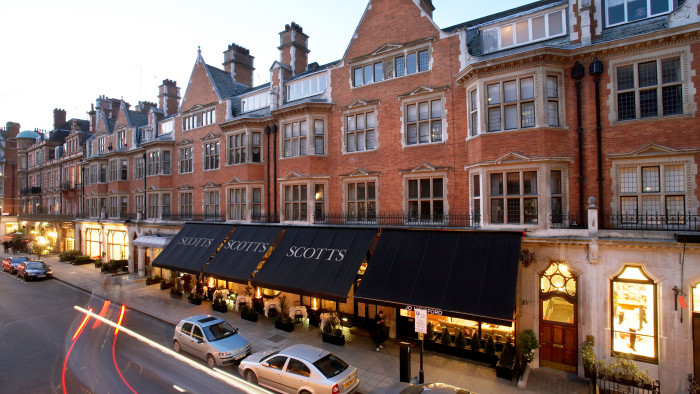Scott’s, London and Union Square Café, New York

Roula Khalaf, Editor of the FT, selects her favourite stories in this weekly newsletter.
Three very different conversations led me to a corner table in Scott’s in Mayfair, awaiting a blonde 30 years my junior.
The first conversation had been with my wife, who was happy to have our non-meat-eating daughter take her place on this dinner date. The second had been over a drink with an American friend who is now a hedge fund manager based in Berkeley Square. He confessed that he eats out on business at least eight times a week, a number far in excess of any restaurant reviewer. When I probed him for the one restaurant he invariably chooses as the most reliable, his immediate response was “Scott’s”.
My final conversation was with Danny Meyer, the New York restaurateur, who I have known for many years and who is now facing the prospect of having to close Union Square Café, the restaurant that established his reputation. Meyer opened the café in what was then a rundown part of the city 30 years ago. His landlord is now demanding a 300 per cent rent increase and a lease renewal of only 10 years.
Over the past 20 years, restaurateurs have opened up parts of numerous cities where other retailers feared to tread. But it now seems they could be priced out of the very neighbourhoods that they have made safe and popular. As cities increasingly come to be defined by their restaurants, how much will their reputations suffer if and when these landmarks are forced to close? What would the citizens of Copenhagen or Girona have had to spend to generate the excitement that the chefs at Noma or El Celler de Can Roca have delivered on their behalf?
London is fortunate in that it still possesses several restaurants that have become landmarks in their own right. The most venerable are Rules, opened in 1798; J Sheekey in 1894; Bentleys in 1916; and Scott’s, which began life on the Haymarket in 1851 before transferring to its current location in 1968.

History is not, of course, enough to guarantee survival in a business where any reputation is only as good as the last meal served, and Scott’s went through a dismal era before its renovation under Richard Caring in 2007. Today, I am reliably informed, it can take more than £35,000 on a busy day.
Union Square Café and Scott’s are different in many ways but their success has two essential factors in common. The first, and less obvious, is just what a gamble opening any restaurant is and quite how strongly that early hunch about a location has to be backed up. Back in 1985 the 27-year-old Meyer was gambling practically his entire savings. By 2007 Caring was not only a successful businessman but also the owner of The Ivy and Le Caprice. He could certainly afford the £3.5m renovation Scott’s required but socially he had far more to lose. A Mount Street address was not then the haven it is today.
The other crucial factor is that the restaurateur must ensure that what is inside the front door of the restaurant matches what is outside. In this regard, Meyer was a visionary. Union Square’s menu of friendly, approachable dishes based on the produce of the nearby Greenmarket struck an immediate chord with those who lived and worked nearby.
Caring started with an advantage in that fish had been the leitmotif of the Scott’s menu for decades. Fish appeals equally to men and women; it commands a reasonably high sales price; and it can be served swiftly to those, particularly at lunch, who are “cash rich but time poor”.
Scott’s menu is written very much with such customers in mind (even printing the restaurant’s wifi password). Two bearded chefs man the magnificent crustacean bar in the centre of the room, compiling many of the cold first courses, a system that allows the kitchen to concentrate on the mains.
Our first courses – six different varieties of oysters served with hot wild boar sausages and a ceviche of sea bass, served cool, laced with avocado and enlivened with jalapeño chilli – were excellent but it was the grilled fish of the day that was stunningly good. This was a whole turbot for two, its skin salted, the flesh still firm and gelatinous. It was the finest version of this dish I have eaten anywhere other than Elkano near San Sebastian, which has the advantage of overlooking the sea. With it, we drank a 50cl carafe of 2011 Alsace Pinot Blanc from Domaine Ostertag and, with dessert, racked up a bill of £230.
Londoners are fortunate that the Scott’s management is intent on preserving its landmark status. I hope New Yorkers will be equally fortunate with the future of 21 E 16th Street.
——————————————-
Scott’s
20 Mount Street, London W1K 2HE, 020 7495 7309; scotts-restaurant.com
Union Square Café
21 E 16th Street, New York 10003, 001 212 243 4020; unionsquarecafe.com
Comments